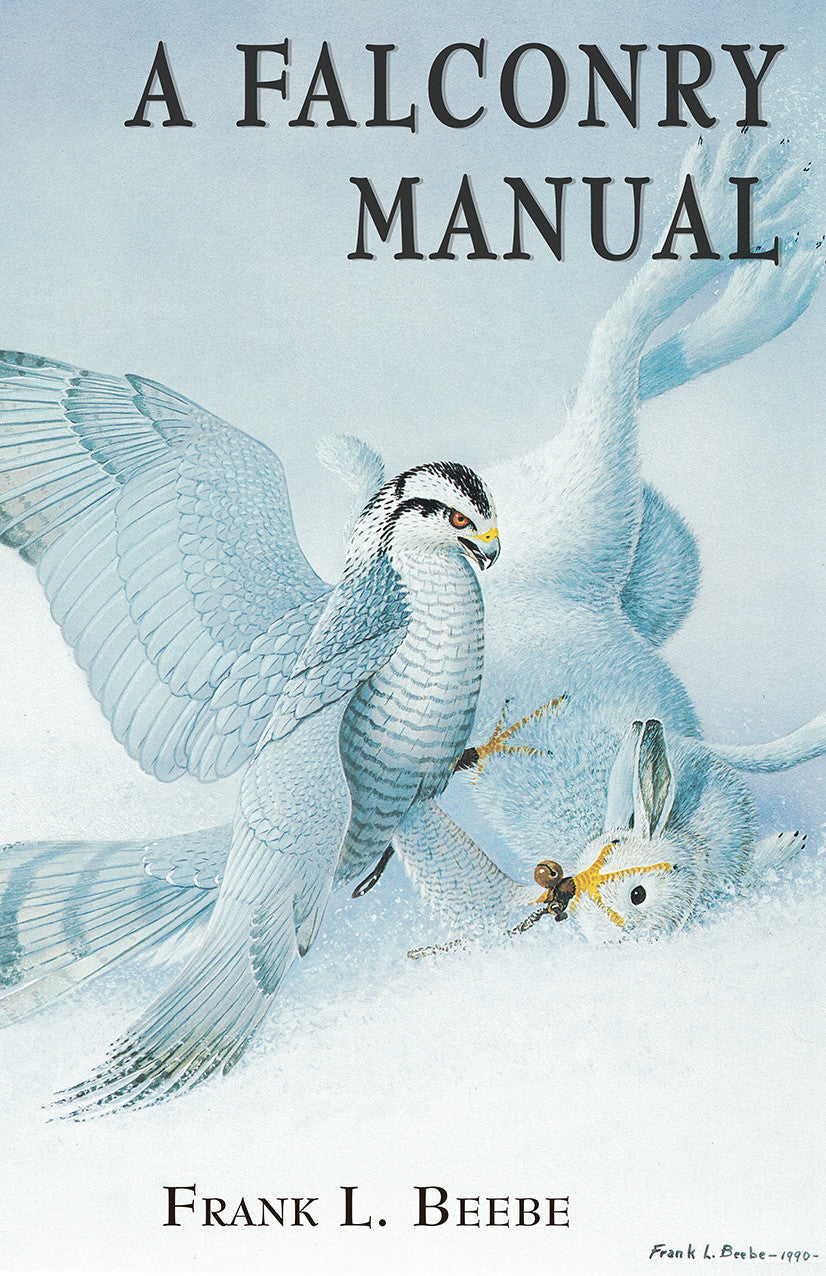

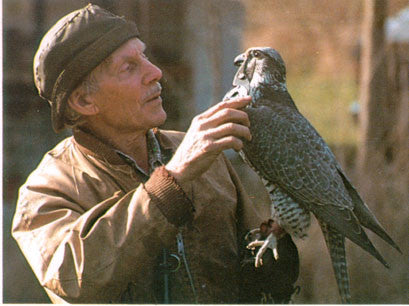
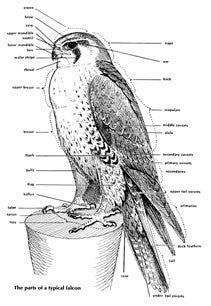
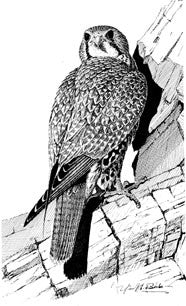
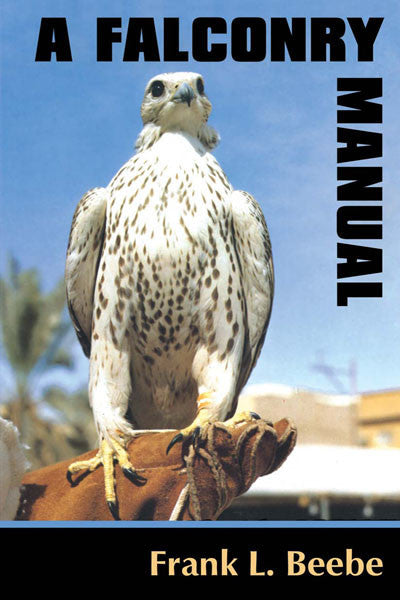
A Falconry Manual
Details
ISBN: 978-0-88839-978-6 [trade paperback]
ISBN: 978-0-88839-034-9 [trade hardback]
ISBN: 978-0-88839-380-7 [epub]
Binding: Trade Paper
Size: 8.5" X 5.5"
Pages: 198
Photos: 30
Illustrations: 127
Publication Date: 2008/2017/2019 [Orig 1984]
Description
A Falconry Manual is a comprehensive, extensively updated version of his out of print book- Hawks, Falcons and Falconry (Hancock House 1976) and The Compleat Falconer (Hancock House 1992).
Drawing on over 50 years of field experience and research, Beebe presents an exhaustive summary of the behavior, capture, and training of the-birds-of-prey. It was Beebe's field studies and practical experience that led to his pioneering successes in breeding captive falcons in the early 1960s. His artistic talents not only contribute to the concise illustrations on how to capture and train birds but how to easily make all falconry hardware.
One of the all-time best books for new Apprentices to learn about training a new hawk or falcon and one of the best selling falconry books ever produced.
Author Biography
The writer of many articles on falconry, Beebe’s interest in the subject has kept him closely allied with the North American Falconry Association, the B.C. Falconry Club and the Falconry Club of America. Formerly a chief illustrator for the Provincial Museum, he lively drawings add an exciting dimension to this falconry manual.
His previous books on the subject are largely responsible for the present status and popularity of this ancient sport. He is not only a leading Peale's and Gyrfalcon researcher but has been a pioneer falcon breeder. Probably more falconers and nature lovers have original Beebe paintings than those of any other artist. Few persons have experienced, let alone been able to capture with paint, the intricate working of the predator-prey responses as Frank.
He flew his last flight on 15 November 2008.
Reviews
This is a great little book. Frank Beebe packs all the essential information around hawk training into this book, drawing on decades of practical experience and research. Beebe writes with the authority of someone who has actually practiced what he is preaching, rather than some authors who seem to have written a falconry book for the sake of personal aggrandizement. He also writes in excellent English, almost with an academic eloquence. He deals with all three classes of falconry birds: buteos, accipiters and falcons, and draws very useful comparisons between them on temperament, character and hunting application. -- Amazon Reviewer
Obituary
Frank Lyman Beebe
May 25, 1914 to November 15, 2008
Bob Herrick and Bill Murrin
An icon of the first order has departed from us. Frank L. Beebe has passed away. His wife, Klara, said Frank had not been eating much since his 2nd stroke in August of this year and had been slowly fading. As of November 14th he was no longer coherent and at 5:30 pm on the 15th his heart stopped. She said he went very peacefully and the weeks before his passing, he had expressed to her that he had no regrets in his life. She said he lived a fuller life than most people, of which there is no doubt. Frank's first stroke earlier in the year deprived him of much of his sight. This was a real blow to an outdoorsman, artist, and writer. He was no longer able to do those things he loved and it was difficult for him to remain cooped up in a house without recourse to pen or brush. However, he looked forward to calls from falconers. Frank had instructed that there be no service for him, therefore he was cremated and the ashes were then buried next to his first wife, Vera. Besides his wife, Klara, he is survived by his four children Kerry, Ervin, Merle, and Marylyn.
It is only appropriate that we provide something of this man's life, given the immeasurable contributions he provided to our sport. Frank was born on May 25, 1914 in Lacombe, Alberta Canada. His parents had immigrated from the U.S. several years before. Frank is the second youngest of seven children. At the time of his birth, his father was off fighting the Great War and did not return until Frank was about three years old. After returning, Frank's father was entitled to a farm provided by the Canadian government under the Soldier Settlement Act. They homesteaded near Lacombe at a time when native Indians still followed a nomadic way of life in the region. In 1924, the Beebe family homesteaded again but this time in the McLeod Valley west of Edmonton, Alberta near Peers. This is where Frank spent his growing-up years. The great boreal forest, also known as the taiga, surrounds the McLeod Valley. Frank spent countless hours exploring this fascinating world and it set the stage for the rest of his life. Mountain Men still trapped fur and mined for gold in the area. These are the men Frank learned outdoor lore from; the knowledge of which allowed him to go on expeditions to the arctic for falcons with few resources at his disposal and no means of calling for help should disaster strike.
He was utterly independent and self-sufficient taking most of his sustenance from the land on these journeys. It was in the McLeod Valley that Frank's artistic ability first became apparent. Much of his free time was spent hunting rabbits, squirrels, and anything else that moved, and then preserving the skins for sale or for his own analysis. He used these real life study skins to learn how to accurately draw the animals in his world. Even until the end of his artistic career, he did not use photographs of specimens when he painted. Instead, he used the mental images captured in his mind from a lifetime of study.
Frank's first written exposure to falconry was through the December, 1920 National Geographic article Falconry, the Sport of Kings by Louis Agassiz Fuertes, which was the primary introductory source to so many would-be American falconers of that era. In 1932, Frank caught a 2nd year goshawk and attempted to work with this bird, but his knowledge of falconry was far too limited at this time to have any real success. Besides, the economy was in the throes of a depression and Frank had to leave home to find a means to provide for himself. It was a difficult time and Frank spoke of whole families in his region that had committed suicide rather than starve to death. He ended up riding the rails in his search for work. He found himself in British Columbia and with his last dollar he decided to take a chance and cross over to Vancouver Island on a ferry. He believed most drifters wouldn't spend the little money they had to take a ferry across the sound. When he arrived he found there was plenty of work and decided to settle down and ended up staying there for the rest of his life, except for a 2 year hiatus in the Okanagan Valley, B.C. after his retirement. During World War II, Frank held a job with the Insect and Range Laboratory doing bubonic plague surveys.
It was understood that the Japanese were attempting to introduce this disease somewhere along Western North America. Frank stayed on this project during the war-years, producing illustrations of insects for the laboratory as well as collecting specimens. Frank was married during this period to Vera Hynes and they had four children together. (Vera passed away in January of 2000. Frank remarried to Klara Roesch on October 13, 2001.) After the war, Frank worked for two years at the B.C. Provincial Museum in Victoria as an illustrator. Frank loved the work but found the salary insufficient to provide for his new family. So he managed to find a job with the Stanley Park Zoo as the zookeeper, a position he held for seven years. During this time, he continued to paint, and even started to write professionally. While at the zoo Frank had the opportunity to join the Provincial Museum sponsored expeditions to Triangle and Langara Islands, where he encountered Peale's peregrines. This would later become the source of his first falconry birds.
In 1953, Frank had the opportunity to rejoin the Museum at a much higher salary than his previous position, this time as Chief Illustrator and diorama artist. He stayed on at the Museum for almost 22 years until his retirement at the age of 60 in 1974. During his tenure there, Frank provided the illustrations for the nature handbooks published by the Museum. The subject matter covered in these numerous handbooks, covered the gamut of the flora and fauna of the region. Nearly every page in these books displays a unique Beebe illustration which, all told, number in the thousands. Some of the dioramas Frank created remain at the Museum to this day. For his final project, the Director of the Museum permitted him to write and illustrate The Falconiformes of British Columbia (1974). This scholarly treatise on the Peale's peregrine and other regional raptors was the definitive work at the time, and is still often referred to today by raptor biologists. This was the pinnacle of an illustrious career at the museum. Given his reputation, Frank was asked to illustrate for a book on flowers outside of the Museum's series. In the book Wild Flowers in the Pacific Northwest (H.R. Larson Publishing Co., 1964) the authors, George & Winifred Hardy, had this to say about Frank: Frank L. Beebe needs no introduction as an artist in the accurate and inimitable portrayal of natural history objects, whether they be insect, amphibian, reptile, bird, mammal and especially flowers. His work is well-known in many published articles, and scientific works.
He has a genius for detailed observation and a rare faculty for recording such in form and colour that makes identification of the real thing a certainty. His unrivaled delineations [sic] of the 'Wild Flowers in the Pacific Northwest' is a continuation of those portrayed in the companion book on the 'Wild Flowers in the Rockies.' Art is worthless in a scientific sense without representation, accurate to the millimeter, of stamen, petal, feather and scale. Because of Mr. Beebe's reputation in artistry and accuracy to the smallest detail, he was selected to illustrate 'Wild Flowers in the Pacific Northwest'. For accuracy and beauty of expression this representation of the wild flowers in the Pacific Northwest is without peer. When asked what made him the naturalist we have all come to know and admire, he said, for every species he was assigned to illustrate, he would seek out every published piece of information available in an attempt to intimately know his subject and thereby represent it in a manner fitting the dignity due each species. This provided an insight into nature few scientists are privileged to experience. Scientists focus their efforts in a fairly narrow compass and are thereby hindered in seeing the larger picture. To Frank, the focused studies of the various scientific disciplines were there to serve him in his tireless effort of connecting the dots of what appears to be unrelated forces, relationships, and activities of nature ' in Frank's mind all things were very much linked. Just because we don't have the eyes to see the connections, doesn't mean they don't exist.
Those with a narrower field of vision ridiculed Frank for his abstract theories, even though he was frequently proven to be correct. He referred to scientists as the high-priests of contemporary society. He felt they were afforded far too much power and status, which was at the expense and detriment of society. For example, he commented on how the scientists at the Museum wanted natural history dioramas to be designed so as to display only a very positive perspective for the public's consumption. He said this cultural mindset could also be observed in nature films where the unappealing side of nature was cut from the finished work. In this way, scientists were portraying nature in a sterile and wholesome manner in order to garner the public's support. Frank saw this as propaganda, pure and simple, in order to manipulate the public and to seek funding and control of wildlife management, and few people challenge this propaganda due to the status of scientists. After retirement, Frank put tremendous effort into painting, carving, writing, and of course falconry. He sold his art in commercial galleries across western Canada. He expanded his work briefly into stone carving. He really enjoyed the media and the wondrous effects he could create from soapstone and jade. Frank's stone carvings were in high demand and made him a handsome profit.
He loved working in three dimensions and had to find new ways to express his talent. He found it in woodcarving and soft sculptures. Frank became the master of creating lifelike effigies of raptors out of foam and latex. The key to their realism was Frank's gift for painting the birds. He was so knowledgeable of the anatomy and coloration of the birds that when his work was complete, they truly looked alive. This is even more remarkable when you consider that he used no reference photos, but did it all from memory. He simply saw the bird in his head. Frank the author, was one of the most prolific and widely read contemporary authors on falconry. Frank and Hal Webster collaborated on what has come to be known as the bible of falconry on this continent ' North American Falconry & Hunting Hawks (1964) ' the most widely used falconry book in North America. This was the first falconry instruction book focused on North American falconry. This signal work did more to promote North American falconry than any other effort before or since. Without this masterpiece, the North American falconry community would be significantly smaller and by extension, in political terms, considerably weaker.
Unfortunately, instead of receiving accolades from seasoned falconers, Frank and Hal were ridiculed by some for opening the door to the masses. A power struggle eventually ensued and when the time was ripe, Frank and Hal were marginalized due to their efforts in trying to make falconry and raptors available to all those who had the wherewithal. In addition, Frank's vocal opposition to the listing of the peregrine as an entire species ' as opposed to subspecies listings ' at the 1965 Peregrine Falcon Madison Conference, engendered even greater animosity toward him from some in the falconry/raptor biology community.
More recent publications of Frank's include: The Myth of the Vanishing Peregrine (1970), Hawks, Falcons and Falconry(1976), A Falconry Manual (1984), FALCOSCAM: Nineteen Eighty Four (1984), The Compleat Falconer (1992), and The Hoax of the Century (1999). David Hancock, owner of Hancock House Publishers, refers to Frank by stating, Frank L. Beebe, the falconer ... has been one of North America's leading falconers. His previous books on the subject are largely responsible for the present status and popularity of this ancient sport. He was not only a leading peale's and gyrfalcon researcher but has been a pioneer falcon breeder having been the first person to breed peregrines in captivity in North America in 1967 (the following year, David Hancock and Larry Schramm were successful at breeding peregrines). Afterward, David Hancock provided a pair of Peale's peregrines to Dr. Heinz Meng and Frank taught Dr. Meng the technique of breeding them. Dr. Meng then taught Dr. Tom Cade who was then able to release peregrines through the Peregrine Fund. In addition to the aforementioned treatises, he has also written numerous scientific articles. One article that has been referenced often is The Marine Peregrines of the Northwest Pacific Coast published in Condor, 1960. Other articles include: Piracy by the Red-tailed Hawk on the Peregrine Falcon (Condor 1960); The Bald Eagle (Victoria Naturalist 1944); and Experiments in the Husbandry of the Peregrine (Raptor Research News 1967).
In addition, he has written extensively in falconry periodicals; one of his finest articles having been published in this prestigious magazine (see Superfalcon, International Falconer, Issues 7, 8, & 9). He was a charter member of the Wild Raptor Take Conservancy, along with being its first President, as well as the first recipient of its lifetime membership award. Frank, with his friend Hal Webster, was co-founder of NAFA. It is unfortunate that this organization never gave Frank or Hal their due when so much is owed to these two outstanding men. Frank was a man who would tell things as he saw them and was not afraid to tell the truth, even if it might offend some people or if the mainstream judges the opinion politically incorrect. He was one who tirelessly fought for what is right & just, making him a champion of the common man, and the falconry community is the richer for it. He did not have an elitist attitude toward the sport, believing that every person with the drive and wherewithal to become a falconer should be able to do so.
A man of Frank's caliber is very rare and we should be very grateful indeed for his time amongst us. It is hard to fully describe his contributions to falconry and our understanding of raptors. What has been provided for above is merely a shadow of the full measure of this Renaissance man. His insight, knowledge, and abilities were beyond most people. He opened our minds to a whole new world of inquiry. He was an icon beyond most falconers' imagination and our community is the richer for his participation in our sport and the poorer for the loss of such a great man. The 20th century will be thought of as a renaissance for falconry and the period between May 25, 1914 to Nov. 15, 2008 must be recorded as the era that produced falconry's greatest contemporary falconer.